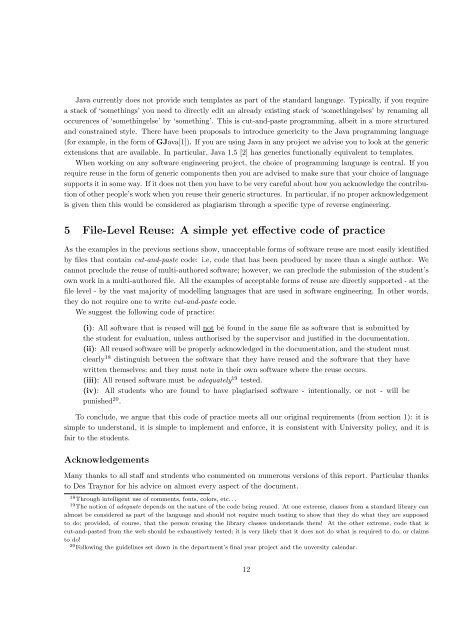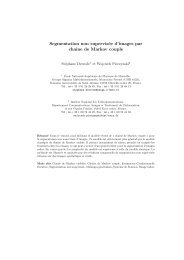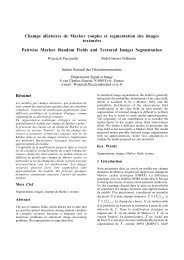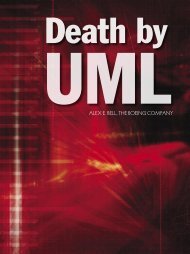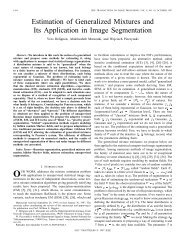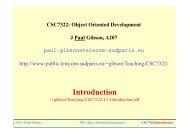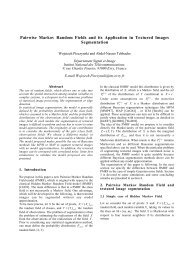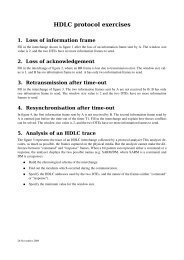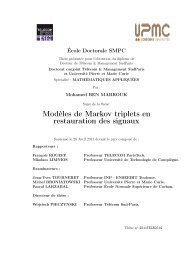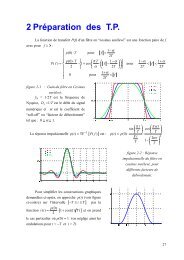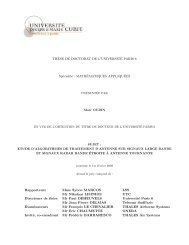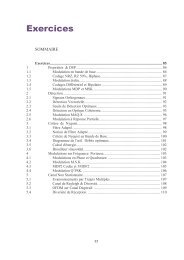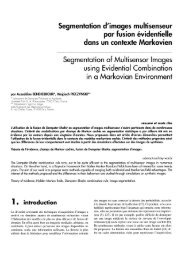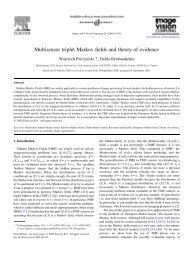Software Reuse In Final Year Projects: A Code of Practice Contents
Software Reuse In Final Year Projects: A Code of Practice Contents
Software Reuse In Final Year Projects: A Code of Practice Contents
You also want an ePaper? Increase the reach of your titles
YUMPU automatically turns print PDFs into web optimized ePapers that Google loves.
Java currently does not provide such templates as part <strong>of</strong> the standard language. Typically, if you requirea stack <strong>of</strong> ‘somethings’ you need to directly edit an already existing stack <strong>of</strong> ‘somethingelses’ by renaming alloccurences <strong>of</strong> ‘somethingelse’ by ‘something’. This is cut-and-paste programming, albeit in a more structuredand constrained style. There have been proposals to introduce genericity to the Java programming language(for example, in the form <strong>of</strong> GJava[1]). If you are using Java in any project we advise you to look at the genericextensions that are available. <strong>In</strong> particular, Java 1.5 [2] has generics functionally equivalent to templates.When working on any s<strong>of</strong>tware engineering project, the choice <strong>of</strong> programming language is central. If yourequire reuse in the form <strong>of</strong> generic components then you are advised to make sure that your choice <strong>of</strong> languagesupports it in some way. If it does not then you have to be very careful about how you acknowledge the contribution<strong>of</strong> other people’s work when you reuse their generic structures. <strong>In</strong> particular, if no proper acknowledgementis given then this would be considered as plagiarism through a specific type <strong>of</strong> reverse engineering.5 File-Level <strong>Reuse</strong>: A simple yet effective code <strong>of</strong> practiceAs the examples in the previous sections show, unacceptable forms <strong>of</strong> s<strong>of</strong>tware reuse are most easily identifiedby files that contain cut-and-paste code: i.e, code that has been produced by more than a single author. Wecannot preclude the reuse <strong>of</strong> multi-authored s<strong>of</strong>tware; however, we can preclude the submission <strong>of</strong> the student’sown work in a multi-authored file. All the examples <strong>of</strong> acceptable forms <strong>of</strong> reuse are directly supported - at thefile level - by the vast majority <strong>of</strong> modelling languages that are used in s<strong>of</strong>tware engineering. <strong>In</strong> other words,they do not require one to write cut-and-paste code.We suggest the following code <strong>of</strong> practice:(i): All s<strong>of</strong>tware that is reused will not be found in the same file as s<strong>of</strong>tware that is submitted bythe student for evaluation, unless authorised by the supervisor and justified in the documentation.(ii): All reused s<strong>of</strong>tware will be properly acknowledged in the documentation, and the student mustclearly 18 distinguish between the s<strong>of</strong>tware that they have reused and the s<strong>of</strong>tware that they havewritten themselves; and they must note in their own s<strong>of</strong>tware where the reuse occurs.(iii): All reused s<strong>of</strong>tware must be adequately 19 tested.(iv): All students who are found to have plagiarised s<strong>of</strong>tware - intentionally, or not - will bepunished 20 .To conclude, we argue that this code <strong>of</strong> practice meets all our original requirements (from section 1): it issimple to understand, it is simple to implement and enforce, it is consistent with University policy, and it isfair to the students.AcknowledgementsMany thanks to all staff and students who commented on numerous versions <strong>of</strong> this report. Particular thanksto Des Traynor for his advice on almost every aspect <strong>of</strong> the document.18 Through intelligent use <strong>of</strong> comments, fonts, colors, etc. . .19 The notion <strong>of</strong> adequate depends on the nature <strong>of</strong> the code being reused. At one extreme, classes from a standard library canalmost be considered as part <strong>of</strong> the language and should not require much testing to show that they do what they are supposedto do; provided, <strong>of</strong> course, that the person reusing the library classes understands them! At the other extreme, code that iscut-and-pasted from the web should be exhaustively tested; it is very likely that it does not do what is required to do, or claimsto do!20 Following the guidelines set down in the department’s final year project and the unversity calendar.12


